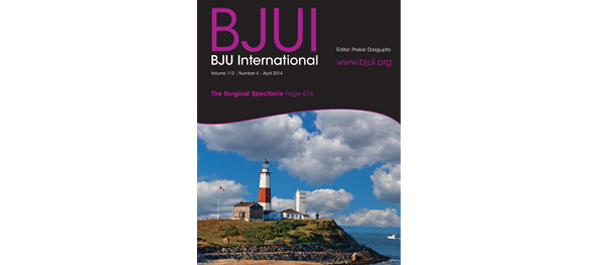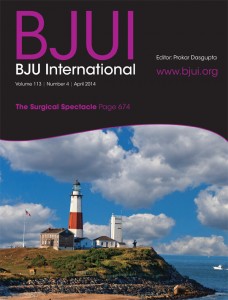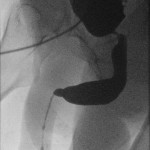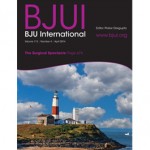Quality matters most where the BJUI and stone disease are concerned
Size (and shape) is important and sometimes strings should be attached, but quality matters most where the BJUI and stone disease are concerned …
The Editor-in-chief of the BJUI has consolidated the journal’s commitment to accepting only the highest quality papers, and this is certainly evident in the upper urinary tract section of this edition, where two studies demonstrate what it takes to be published in the journal nowadays.
In the first article, Kerri Barnes and colleagues from University of Iowa Department of Urology [1] have followed their own department’s earlier retrospective analysis of the benefit of “tethered stents” [2], by analysing the safety and effectiveness of this approach in a prospective, randomised controlled trial. It is often stated that randomised controlled trials are difficult in surgical disciplines, but this study affirms the proverb that “where there’s a will, there’s a way”. Although there was a substantial drop out in the number of patients that could have been included (three quarters of the patients approached for the study declined to be involved as they wished to determine the nature of the stent left in situ), statistical significance was not approached for any of the key concerns that leaving a stent on a string might cause for either the patient or their surgeon.
Furthermore, they have shown that that leaving the strings in place allowed patients to remove their stents significantly earlier (and in the convenience of their own home), than if they had to return to hospital for cystoscopic removal a week or so post-operatively. Despite the established knowledge that stents contribute to postoperative morbidity and can adversely affect quality of life, and the increasing evidence that stents are not required in “uncomplicated” ureteroscopy, it is clear that most urologists continue to leave a stent for a sense of security after performing ureteroscopic stone surgery. Shorter stent dwell times may help reduce the overall burden of stent related symptoms, and it is worth emphasising that none of the patients whose stent was removed at 7 days post operatively had any adverse consequences; neither did the 15% of this group whose stents fell out even earlier. As Fernando and Bultitude [3] comment in the associated editorial, the next question is: “If you are going to place a stent, how long does the stent need to stay for?” Perhaps, in order to emphasise that, where stent bother is concerned, shorter is better, this should be re-phrased as “how little time is enough time for a stent to stay in”…
In the second, Will Finch, from Norfolk and Norwich University Hospital, and his colleagues from Addenbrooke’s Hospital, Cambridge [4], have shown that stone size assessments from CT are most reliably calculated by a 3D-reconstructed stone volume. They have demonstrated that the maximum diameter of a stone tends to predict its overall shape such that a rugby ball-shaped stone (a “prolate ellipsoid”) has the polar diameter as the major axis, whereas a disc-shaped stone (an “oblate ellipsoid”) has the equatorial diameter as its major axis. Stones less than 9mm in diameter tended to be prolate, whilst those of 9–15 mm in diameter tended to be oblate; stones larger than 15 mm in diameter approach the more “random” shape of a scalene ellipsoid, for which the formula used to calculate stone volume (length (l) × width (w) × depth (d) × π × 0.167, which is often simplified to (l × w × d) / 2 in clinical practice) can be used.
However, if this is used for all stones regardless of their size and shape, rugby-ball and disc-like stones of less than 15mm in size are likely to have their volume over-estimated. Accordingly, the authors challenge the guidance of the EAU regarding stone volume calculations [5] to recommend that formulae based on the shape of the stone (π/6*a*a*c* for an oblate and π/6*a*b*b* for a prolate stone – see the paper itself to make sense of this) offer a more accurate assessment of stone volume.
Whilst these formulae are recommended for day-to-day calculations to guide treatment choices, they emphasise that 3D-reconstructed stone volumes should be used to report stone volume in research papers. In an age of stone surgery where CTKUB is so widely used in patients’ imaging assessment, and accepting that stone volume is the key determinant of achieving a stone free patient, this would allow the most accurate comparisons between the effectiveness of different surgical treatments.
Both articles are simple, straightforward, and well conducted studies that apply to the every-day practice of stone surgery. High quality papers are, of course, only really of benefit if they change practice for the better. So why not speak to your radiologist today about adding stone volume assessments to CTKUB reports (and point them to Finch et al. for the evidence) or even do it yourself! And the next time you put in a stent, reassure yourself, and the patient,
that there is no harm, and many benefits, in having some strings attached …
Daron Smith
University College Hospital, London, United Kingdom
References
- Barnes KT, Bing MT, Tracy CR. Do ureteric stent extraction strings affect stent-related quality of life or complications after ureteroscopy for urolithiasis: a prospective randomised control trial. BJU Int 2014; 113: 605–609
- Bockholt N, Wild T, Gupta A, Tracy CR. Ureteric stent placement with extraction strings: no strings attached? BJU Int 2012; 110 (11 Pt C): E1069–1073
- Fernando A, Bultitude M. Tether your stents! BJU Int 2014; 113: 517–518
- Finch W, Johnston R, Shaida N, Winderbottom A, Wiseman O. Measuring stone volume – three-dimensional software reconstruction or an ellipsoid algebra formula? BJU Int 2014; 113: 610–614
- Tiselius HG, Alken P, Buck C et al. European Association of Urology 2008 Guidelines on Urolithiasis. Available at: https://www.uroweb.org/fileadmin/user_upload/Guidelines/Urolithiasis.pdf. Accessed 17 June 2012





Welcome Daron as our Consulting Editor for stone disease, A few colleagues were worried that we had abandoned this important condition. Absolutely NOT. We just need your very best papers which will contribute to the literature and be cited by your colleagues.